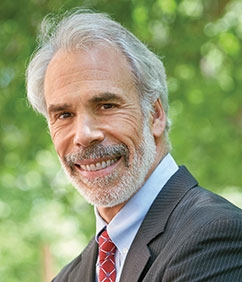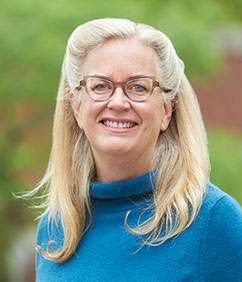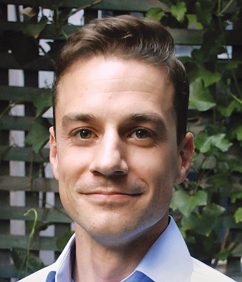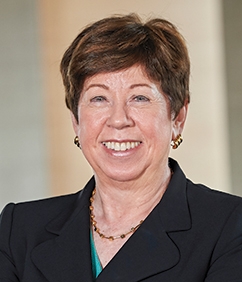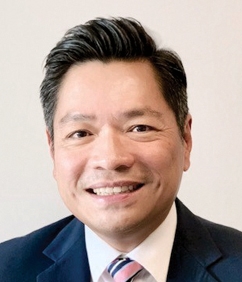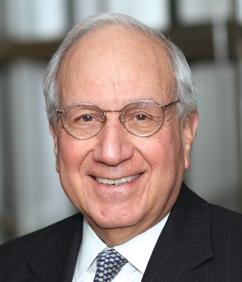A New Financial Landscape
NYU Law faculty and alumni have helped map and pioneer the movement toward sustainable investing.
BY ATTICUS GANNAWAY, ALANA GRAMBUSH, MICHAEL OREY, AND EMILY ROSENTHAL
ILLUSTRATION BY TRACI DABERKO
It’s not just about the money, a growing number of investors believe. Socially responsible investing—widely known as ESG, for the environmental, social, and governance factors often used as investment criteria—has become increasingly popular in recent years. Global ESG fund assets more than doubled in two years, reaching $2.74 trillion at the end of 2021, according to Morningstar.
With ESG involving aspects of finance, law, and the public interest, it’s not surprising that the area is a center of interest and activity for both NYU Law alumni and faculty. Law School graduates have helped shape the development of ESG investing and play leading roles in the industry, while faculty members have examined its evolution through discussion and research. We spoke to some of them about their work.
Faculty and Centers
The Big Picture
NYU Law’s Institute for Corporate Governance & Finance (ICGF) has explored the development of ESG through conferences, lectures, and roundtables. In a Q&A, Edward Rock, co-director of ICGF and Martin Lipton Professor of Law, explains the basics of ESG and discusses some of the trends he is seeing.
At an NYU Law Forum, you called ESG “the most important issue in corporate governance today.” What is ESG, and what makes the debate around it important?
ESG refers to “environmental, social, and governance” issues facing corporations. Over the past five years, shareholders have increasingly focused on the importance of these factors for the corporations they hold. This is for two reasons. First, shareholders often are flesh-and-blood human beings who care about issues in addition to profits, and have increasingly used their shareholdings to put these issues on the corporate agenda. Second, many shareholders have come to believe that these factors—including climate change and sustainability, workers’ rights, and inequality—affect the financial returns of the companies they hold, and the companies need to pay attention to them.
What are some specific examples of ESG that companies have implemented?
A good example is Shell Oil’s commitment to net-zero carbon emissions by 2050 and a 20 percent reduction by 2030. The cynical view is that they will achieve this primarily by selling off assets. Another example is Nestlé: the CEO told CNBC that sustainability concerns among its younger customers were “off the charts” and a major influence on purchasing decisions. The company has committed to cut greenhouse gas emissions by 50 percent by 2030 and [reach] zero by 2050.
You established the Institute for Corporate Governance & Finance in the spring of 2017. How has the profile of ESG changed since then, and what has driven that change?
In the past five years, ESG has moved from the fringes to the mainstream of corporate governance. Although there is no clear answer to why this has happened, I suspect it comes from a convergence of widespread concern over climate change with a growing concern over inequality. With legislative gridlock in DC, many have turned to the corporate sector as a substitute force for change. It remains an open question whether shareholder-driven climate or social activism can be successful on its own, or whether it is best understood as a lever for influencing the political debate and the alignment of interests. Either way, corporations have started to take these issues seriously.
What have you found to be the most challenging question related to ESG?
There is no common and accepted definition of ESG. What counts as an “environmentally responsible” mutual fund? Which social issues count? Do ESG mutual funds behave differently than other funds? How much, if any, trade-off is there between ESG and profits? In the wake of Russia’s invasion of Ukraine, do arms manufacturers count as an ESG investment? We are at the very beginning of a widespread effort systemically to incorporate environmental and social factors into corporate and investor decision-making, and we do not have generally accepted metrics for defining or measuring many of the relevant factors. While someday ESG may be as well defined as accounting with its equivalent to GAAP [generally accepted accounting principles] standards, we are not there yet.
ESG and Compliance
In recent years, the Program on Corporate Compliance and Enforcement (PCCE) has provided a forum for dialogue and thought leadership on ESG issues that intersect with corporate compliance and enforcement. “To establish an effective compliance function—one that encourages employees to genuinely give priority to ethical concerns and avoid unethical conduct even when it likely would be profitable—companies must install an ethical culture in the roots of the firm,” says Jennifer Arlen ’86, Norma Z. Paige Professor of Law and PCCE’s faculty director. Good governance, she says, can foster such a culture, and a critical component of good governance is ensuring that the firm actively seeks to deter and is appropriately responsive to evidence of discrimination and sexual harassment. Evidence shows that companies that adopt a dismissive approach to such allegations create a culture that leads to other violations and increased legal liability. PCCE has also launched a directors’ academy that, among other issues, examines directors’ governance responsibility with respect to environmental risks.
ESG and Social Entrepreneurship
The Grunin Center for Law and Social Entrepreneurship centers its research and other work on the businesses whose main focus is driving social change and improving human welfare. ESG goals, by contrast, are often adopted by companies whose primary purpose is profit, but that seek to add social welfare enhancement as a legitimate business aim.
Still, the distinction is not as clear as it used to be. “As companies become more intentional about advancing positive societal and environmental goals—not just mitigating against adverse effects—the lines do blur,” says Professor of Clinical Law Deborah Burand, a Grunin Center faculty director.
Grunin Center Executive Director Amaris White notes that center research and support include a focus on impact investors, whose investment strategy aims to achieve social or environmental goals, in addition to profit. The center’s Social Enterprise Law Tracker is a database of state laws authorizing new forms of business that “seek to create positive social and environmental impacts in addition to financial returns.” In addition, Burand has researched how law firms participating in NYU Law’s interview process are developing ESG and impact investing practices.
An Eye on Regulators
NYU Law’s Institute for Policy Integrity has tracked and commented on regulatory activity involving ESG in the past few years. Directed by Dean Emeritus Richard Revesz, AnBryce Professor of Law, Policy Integrity is a nonpartisan think tank focused on improving the quality of governmental decision-making.
Policy Integrity has submitted comments on proposed rules from the US Department of Labor involving retirement plan fiduciaries’ ability to integrate ESG considerations into investment and proxy voting decisions. And recently the institute prepared comments on the US Securities and Exchange Commission’s proposed new requirements for ESG fund names and ESG funds’ disclosures on investing and voting practices. “What does it mean to be a green fund?” asks Jack Lienke ’11, Policy Integrity’s regulatory policy director. “What does it mean to be a socially responsible fund?... There are all sorts of things that could be ESG criteria, and this disclosure rule is focused on giving investors more information.”
Law Firm Practice
Paradigm Shift
Martin Lipton ’55, a founding partner of Wachtell, Lipton, Rosen & Katz and a preeminent takeover defense specialist, has spent decades asserting the virtues of stakeholder corporate governance, a model in which corporations consider their full range of stakeholders—including employees, customers, suppliers, and communities—rather than focusing exclusively on shareholder profits. He has long argued against the “Friedman doctrine,” named after Chicago School economist Milton Friedman, whose advocacy of shareholder profit-oriented governance once enjoyed widespread influence. Today, with the growth of ESG, Lipton’s philosophies have found new traction.
In a white paper written at the invitation of the World Economic Forum (WEF), the international organization that hosts an annual meeting of political and corporate leaders in Davos, Switzerland, Lipton and Wachtell colleagues drew on almost 40 years of Lipton’s client memos and articles to produce a blueprint for recalibrating the relationship between corporations and investors, and to encourage collaboration among businesses, shareholders, and other stakeholders in the service of long-term value that encompasses ESG principles. “The New Paradigm: A Roadmap for an Implicit Corporate Governance Partnership Between Corporations and Investors to Achieve Sustainable Long-Term Investment and Growth” touches on standards for ESG and risk management, the proper tone at the top of corporate culture, board composition and duties, and the desirability of voluntary corporate change rather than compelled change through regulatory reform. Lipton presented his paper at a 2016 meeting of the WEF’s International Business Council, and discussed the treatise at the 2017 launch event for NYU Law’s Institute for Corporate Governance & Finance.
The ideas Lipton has long espoused have spread through the corporate zeitgeist with remarkable speed. In 2019, the Business Roundtable revised its longtime definition of a corporation to focus on stakeholder capitalism after decades of upholding shareholder primacy; a year later, the WEF’s Davos Manifesto 2020 embraced stakeholder governance as key to “shared and sustained value creation.”
In a client memo released last year, Lipton and his colleagues write that the upheaval created by the COVID-19 pandemic, in combination with growing acceptance of ESG, stakeholder governance, and long-term investment strategies, is “propelling a decisive inflection point in the responsibilities of boards of directors…. The salient question has shifted from whether a board of directors should take into account the interests of stakeholders other than shareholders, to how a board should do so.”
A Fast-Changing Practice Area
As ESG investing has grown, so have ESG practices at law firms. Many large firms have launched ESG practice groups, representing corporations and investors, and lateral recruitment in the area has heated up. “ESG was not a commonly known term 10 years ago. It, however, has now penetrated nearly all aspects of law,” says Betty Moy Huber ’96, who joined Latham & Watkins earlier this year as global co-chair of the firm’s ESG practice.
“The ESG practice is a reflection of the broader discussion around the role each of us plays in creating a sustainable future, and public companies in particular are more receptive and aware of their responsibilities to at least indicate an understanding of its importance, and possibly to go far beyond that and contribute meaningfully,” says Davis Polk partner Ning Chiu ’95. “The practice has evolved to support companies in those efforts, focused on each company’s particular strategy.”
“ESG quite literally touches almost every aspect of corporate work,” says Julia Lapitskaya ’10, a partner in the securities regulation and corporate governance practice group at Gibson, Dunn & Crutcher. “We talk about ESG in IPOs, financings, tax strategy, public company reporting, and the like. Unsurprisingly, the ESG practice has evolved as well, and we went from focusing on G—governance—to talking about ESG more broadly.”
“There’s questions relating to climate change risk, to fair wages, inclusion and diversity or human rights in supply chains, energy transition, and sustainable finance,” notes Huber. “Given the broad nature of ESG, the issues and matters I’m handling often require a multidisciplinary approach, and so I’m quarterbacking a team of experts.”
“My favorite part about working in ESG is that it rewards those that are intellectually curious and entrepreneurial,” says Kirkland & Ellis partner Sofia Martos ’10, a member of the firm’s ESG and impact practice group. “The space is really evolving every day, and clients pose new questions all the time, so you have to constantly be learning and thinking about new ways to assist your clients.”
The Investor Perspective
Early Adopter
At NYU Law, Keren Raz ’10 says she had numerous conversations with peers who, like her, were also interested in business, law, and social impact. These conversations led her to found the Law and Social Entrepreneurship Association, now called the Social Enterprise & Startup Law Group. “At the time, thinking about the role that lawyers could play at the intersection of law, business, and social impact was a really, really new area,” says Raz, who worked with Professor Helen Scott to develop a social entrepreneurship curriculum at the Law School.
“Keren was ahead of her time in terms of understanding the direction in which the world was heading, and helping us, indeed pushing us, to be at the forefront of that development for lawyers and law students,” says Scott, who notes that she still consults with Raz as the social entrepreneurship curriculum at the Law School continues to expand.
After graduation, Raz was hired to implement an ESG program at Apollo Global Management, where she served as a sustainability and ESG advisor for eight years. Now, as a senior responsible investment manager at APG, a European pension investor, Raz serves as the ESG lead for the private equity, hedge funds, and alternative credit asset classes. She reviews prospective investment managers to ensure that their investments meet ESG requirements set by client policies and that these investments are performing well on ESG issues overall.
“When I graduated law school, ESG was still a relatively young field…and there was concern in finance that ESG required a financial trade-off. ESG was misunderstood as philanthropy,” says Raz. “Now, we have a broader understanding of ESG and growing data that shows the positive financial impacts from good ESG management.”
Scaling Up
Jimmy Yan ’97 began his legal career as a public interest lawyer with the Advocates for Children of New York, helping children who were immigrants or children of immigrants gain access to education and other resources. Understanding that larger systemic issues were at the root of his clients’ challenges, he moved into government work. As general counsel in the Office of the Manhattan Borough President, Yan was responsible for representing the borough president on one of New York City’s pension fund boards.
In that role, Yan says, he was compelled by the need for investors and businesses to manage environmental sustainability and transparency in governance. “It is exciting to see how creating positive societal impacts can and does generate stronger financial returns and broader wealth for society,” he says, noting that ESG is an important part of legal fiduciary duty. “ESG had been a blind spot in investing, which made for short-sighted decisions. Now, much of the industry sees that ESG factors are financially material and relevant and need to be included in investment decision-making.”
In 2014, Yan became special counsel to the chief investment officer in the New York City Comptroller’s Office, where he led the office’s ESG strategy on sustainable investment initiatives for New York City’s pension funds. In 2021, Yan’s title became formalized as director of ESG. “We are seeing ESG officers being appointed across the investment industry where they did not exist five years ago,” says Yan, “but we need to make sure ESG is genuinely integrated in the investment process.”
Analyzing Climate Risks
Among investment managers, BlackRock has stood out for its efforts in recent years to integrate ESG into its fund management. Matthew Mallow ’67, LLM ’68 was BlackRock’s general counsel from 2012 through 2016 and then a vice chair until his retirement early in 2021. Christopher Meade ’96 is now BlackRock’s general counsel and chief legal officer.
Mallow says that for many years BlackRock, like other investment managers, focused on the G in ESG—good corporate governance—but adds that the effects of climate change have dramatically increased the importance in investment decision making of the E in ESG. Looking ahead, he expects that regulators such as the US Securities and Exchange Commission will create increased standardization in climate-related disclosure metrics. “Right now, there’s a wide range of qualitative and quantitative disclosure of these issues and they’re not always comparable. In fact, they are often opaque in terms of comparability,” says Mallow. “As investors increasingly become able to evaluate and compare climate risks, they will make better-informed long-term investment decisions on behalf of their clients.”
Michael Orey is public affairs director, Atticus Gannaway is senior writer, Alana Grambush is a writer, and Emily Rosenthal is a public affairs officer at NYU Law.
Photo credits: Davis Polk & Wardwell LLP (Chiu); Jerry Goldberg (Mallow)
Posted September 8, 2022.


